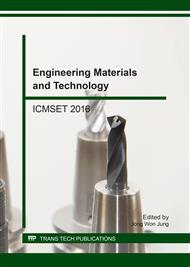[1]
V. Chopade, A. Phatak, A. Upaganlawer, A. Tankar, Pharmacog, Green tea (Camellia sinensis): chemistry, traditional, medicinal uses and its pharmacological activities-a review, Pharmacol. Rev. 2 (2008) 157–162.
Google Scholar
[2]
U. Wei, J. Z. Lu, J. Ren, H. U. Yaoxing, Optimization of extracting method for tea polysaccharide, J, Wuhan Bioeng. Inst. 3 (2007) 201–204.
Google Scholar
[3]
T. Xia, S. Shi, X. Wan, Impact of ultrasonic-assisted extraction on the chemical and sensory quality of tea infusion, J. Food Eng. 74(4) (2006) 557–560.
DOI: 10.1016/j.jfoodeng.2005.03.043
Google Scholar
[4]
S. P. Nie, M. Y. Xie, A review on the isolation and structure of tea polysaccharides and their bioactivities, Food Hydrocolloids. 25(2) (2011) 144–149.
DOI: 10.1016/j.foodhyd.2010.04.010
Google Scholar
[5]
X. Wei, F. Mao, X. Cai, Y. Wang, Composition and bioactivity of polysaccharides from tea seeds obtained by water extraction, Int. J. Biol. Macromol. 49(4) (2011) 587–590.
DOI: 10.1016/j.ijbiomac.2011.06.016
Google Scholar
[6]
Y. Wang, Z. Yang, X. Wei, Antioxidant activities potential of tea polysaccharide fractions obtained by ultra filtration, Int. J. Biol. Macromol. 50(3) (2012) 558–564.
DOI: 10.1016/j.ijbiomac.2011.12.028
Google Scholar
[7]
L. Guo, X. Du, J. Lan, Q. Liang, Study on molecular structural characteristics of tea polysaccharide, Int. J. Biol. Macromol. 47(2) (2011) 244–249.
Google Scholar
[8]
X. R. Wang, S. G. Deng, J. Q. Kan, Research progress on tea polysaccharide, Cereals & Oils. 6 (2006) 43–46.
Google Scholar
[9]
H. X. Chen, M. Zhang, B. J Xie, Components and antioxidant activity of polysaccharide conjugate from green tea, Food Chem. 90(1-2) (2005) 17–21.
DOI: 10.1016/j.foodchem.2004.03.001
Google Scholar
[10]
S. R. Stapleton, Selenium: an insulin mimetic, Cell. Mol. Life Sci. 57(13-14) (2000) 1874–1879.
DOI: 10.1007/pl00000669
Google Scholar
[11]
Rayman, P. Margaret, The importance of Selenium to human health, Lancet. 356(9225) (2000) 233–241.
DOI: 10.1016/s0140-6736(00)02490-9
Google Scholar
[12]
M. J. Rock, R. L. Kincaid, G. E. Carstens, Effects of prenatal source and level of dietary Selenium on passive immunity and thermometabolism of newborn lambs, Small Ruminant Res. 40(2) (2001) 129–138.
DOI: 10.1016/s0921-4488(01)00167-5
Google Scholar
[13]
W. C. Hawkes, D. S. Kelley, P. C. Taylor, The effects of dietary Selenium on the immune system in healthy men, Biol. Trace Elem. Res. 81(3) (2001) 189–213.
DOI: 10.1385/bter:81:3:189
Google Scholar
[14]
X. Yuan, C. Tang, Lead effect on DNA and albumin in chicken blood and the protection of Selenium nutrition, J. Environ. Sci. Health A. 34(9) (1999) 1875–1887.
DOI: 10.1080/10934529909376935
Google Scholar
[15]
D. J. Hoffman, G. Heinz, Effects of mercury and Selenium on glutathione metabolism and oxidative stress in mallard ducks, Toxicol. Chem. 17(2) (1998) 161–166.
DOI: 10.1002/etc.5620170204
Google Scholar
[16]
M. Navarro-Alarcon, C. Cabrera-Vique, Selenium in food and the humanbody: a review, Sci. Total Environ. 400(1-3) (2008) 115–141.
DOI: 10.1016/j.scitotenv.2008.06.024
Google Scholar
[17]
J. Fan, J. Zhang, Q. Tang, Y. Liu, A. Zhang, Y. Pan, Structural elucidation of a neutral fuco galactan from the mycelium of Coprinus comatus, Carbohyd. Res. 341 (2006) 1130–1134.
DOI: 10.1016/j.carres.2006.03.039
Google Scholar
[18]
W. X. Fang, P. W. Wu, R. Z. Hu, Geochemical research of the impact of Se-Cu-Mo-V-bearing coal layers on the environment in Pingli County, Shaanxi Province, China, J. Geochem. Explor. 80(1) (2003) 105–115.
DOI: 10.1016/s0375-6742(03)00186-9
Google Scholar
[19]
A. L. Molan, A. M. Faraj, Effect of Selenium-rich green tea extract on the course of sporulation of Eimeria oocysts, J. Dental Medical Sci. 14(4) (2015) 68–74.
Google Scholar
[20]
X. Shen, L. Nie, H. Liu, N. Wu, Effects of Zinc and Selenium Rich Green Tea of Fenggang in Guizhou Province on Mouse Antioxidant Ability, J. Guiyang Med. Coll. 39 (2014) 642–645.
Google Scholar
[21]
L. M. Wang, W. S. Xia, Optimization of extraction parameters for tea polysaccharides, Food Sci. 26 (2005) 171–174.
Google Scholar
[22]
H. Li, L. Ma, S. J. Zhang, Extraction of tea polysaccharides by microwave technique, Life Sci. Instrum. 8 (2010) 50–53.
Google Scholar
[23]
Y. C. Huang, Y. F. Ma, Q. R. Xie, X. Y. Huang, Y. N. Huang, Study on effects of ultrasonic on extracion of tea polysaccharide and changes of molecular weight, Food Sci. 28 (2007) 170–173.
Google Scholar
[24]
B. Q. Fu, M. Xie, P. Zhou, S. Nie, Y. Wang, The extraction of tea polysaccharide by cellulase degradation, J. Wuxi Univ. Light Ind. 21 (2002) 362–366.
Google Scholar
[25]
D. M. Wu, T. T. Gao, H. X. Yang, Y. Du, C. Li, L. Wei, T. Y. Zhou, J. M. Lu, H. T. Bi, Simultaneous microwave/ultrasonic-assisted enzymatic extraction of antioxidant ingredients from Nitraria tangutorun Bobr. Juice by-products. Ind. Crop. Prod. 66 (2015).
DOI: 10.1016/j.indcrop.2014.12.054
Google Scholar
[26]
T. Wang, W. Li, H. W. Chen, X. L. Chen, J. J. Diao, Microwave-ultrasonic assisted extraction of Cordycepin from cultured mycelia of Cordyceps militaris, Food Sci. 31(10) (2010) 86–90.
Google Scholar
[27]
S. Kaiser, S. G. Verza, R. C. Moraes, V. Pittol, E. Maribe, C. Penaloza, G. G. Ortega, Extraction optimization of polyphenols: oxindole alkaloids and quinovic acid glycosides from cat's claw bark by Box-Behnken design. Ind. Crops. Prod. 48 (2013).
DOI: 10.1016/j.indcrop.2013.04.026
Google Scholar
[28]
H. E. A. Tinsley, S. D. Brown, Handbook of applied multivariate statistics and mathematical modeling. Academic Press, (2000).
Google Scholar
[29]
E. Vazquez-Delfin, D. Robledo, Y. Freile-Pelegrin, Microwave-assisted extraction of the Carrageenan from hypnea musciformis (Cystocloniaceae, Rhodophyta), J. Appl. Phys. 26(2) (2014) 901–907.
DOI: 10.1007/s10811-013-0090-8
Google Scholar
[30]
M. A. Rostagno, M. Palma, C. G. Barroso, Ultrasound-assisted extractionof soy isoflavones, J. Chromatogr. A. 1012(2) (2003) 119–128.
DOI: 10.1016/s0021-9673(03)01184-1
Google Scholar
[31]
J. Chandrapala, C. M. Oliver, S. Kentish, M. Ashokkumar, Use of power ultrasound to improve extraction and modify phase transitions in food processing, Food Rev. Int. 29(1) (2013) 67–91.
DOI: 10.1080/87559129.2012.692140
Google Scholar
[32]
Z. Ying, X. Han, J. Li, Ultrasound-assisted extraction of polysaccharides from mulberry leaves, Food Chem. 127(3) (2011) 1273–1279.
DOI: 10.1016/j.foodchem.2011.01.083
Google Scholar
[33]
L. E. Garcia-Ayuso, M. D. L. de Castro, Employing focused microwaves to counteract conventional Soxhlet extraction drawbacks, TrAC-Trends Anal. Chem. 20(1) (2001) 28–34.
DOI: 10.1016/s0167-2940(01)90089-5
Google Scholar


